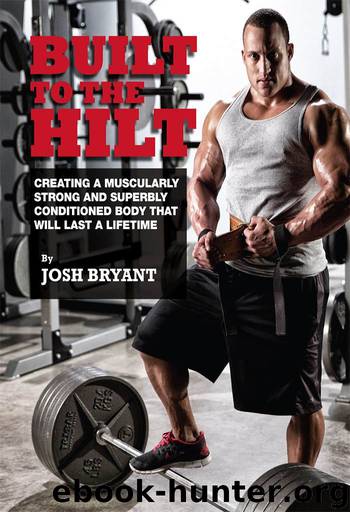Built To The Hilt: Creating A Muscularly Strong And Superbly Conditioned Body That Will Last A Lifetime by Josh Bryant

Author:Josh Bryant [Bryant, Josh]
Language: eng
Format: epub
Publisher: The Creative Syndicate
Published: 2014-07-15T18:30:00+00:00
Science, as well as obvious anecdotal evidence from the trenches, confirms the effectiveness of bands and chains for becoming more powerful. Let's look at how this directly benefits your muscle building quest by comparing a full-range-of-motion deadlift to a quarter-rack pull (a quarter top-end range-of-motion deadlift). You can obviously handle much more weight for a quarter rep than for a full rep. By adding bands or chains to the bar, as you lift the weight toward lockout, every inch of the way has additional resistance applied to the barbell. This means the rep will be challenging throughout the entire range of motion. Essentially, it is like a synergistic hybrid-blend exercise because you are getting the benefit of a full-range-of-motion exercise and essentially the benefits of an overload partial movement. Because of maximal overload throughout the entire movement, proper implementation will result in maximum muscle growth. Proper periodization is paramount to success because an exercise with additional band or chain resistance makes the exercise much higher intensity than the movement being performed in the traditional sense. Because of greater tension throughout the entirety of the movement, at no point can you put on cruise control.
Bands and chains can help injured lifters perform core movements through a full range of motion in some instances where they may not otherwise be able to perform.
Shoulder injuries are common among iron game veterans who have performed heavy pressing movements, year in, year out. Use the bench press as an example. Many of these lifters experience pain on the bottom portion of lift, so in the past they have generally had the option of dropping the movement altogether or performing partials.
Once again, bands and chains are a game changer because the weight will be much less at the bottom portion of the lift (where it needs to be) and resistance will increase as the weight approaches the top end of the lift. This will help produce sufficient overload, along with letting this lifter continue to train injury free. The same can be said of deadlifts. Many lifters with lower back problems are able to perform deadlifts because of the lighter load off the bottom.
Download
This site does not store any files on its server. We only index and link to content provided by other sites. Please contact the content providers to delete copyright contents if any and email us, we'll remove relevant links or contents immediately.
Periodization Training for Sports by Tudor Bompa(8170)
Bodyweight Strength Training by Jay Cardiello(7842)
Born to Run: by Christopher McDougall(7065)
Inner Engineering: A Yogi's Guide to Joy by Sadhguru(6725)
Asking the Right Questions: A Guide to Critical Thinking by M. Neil Browne & Stuart M. Keeley(5644)
The Fat Loss Plan by Joe Wicks(4849)
Bodyweight Strength Training Anatomy by Bret Contreras(4614)
Yoga Anatomy by Kaminoff Leslie(4306)
Dynamic Alignment Through Imagery by Eric Franklin(4118)
Science and Development of Muscle Hypertrophy by Brad Schoenfeld(4089)
ACSM's Complete Guide to Fitness & Health by ACSM(3989)
Exercise Technique Manual for Resistance Training by National Strength & Conditioning Association(3956)
The Four-Pack Revolution by Chael Sonnen & Ryan Parsons(3932)
Bodyweight Strength Training: 12 Weeks to Build Muscle and Burn Fat by Jay Cardiello(3915)
The Ultimate Bodybuilding Cookbook by Kendall Lou Schmidt(3886)
Yoga Anatomy by Leslie Kaminoff & Amy Matthews(3863)
American Kingpin by Nick Bilton(3757)
Nutrition for Sport, Exercise, and Health by Spano Marie & Kruskall Laura & Thomas D. Travis(3715)
Yoga Therapy by Mark Stephens(3703)
